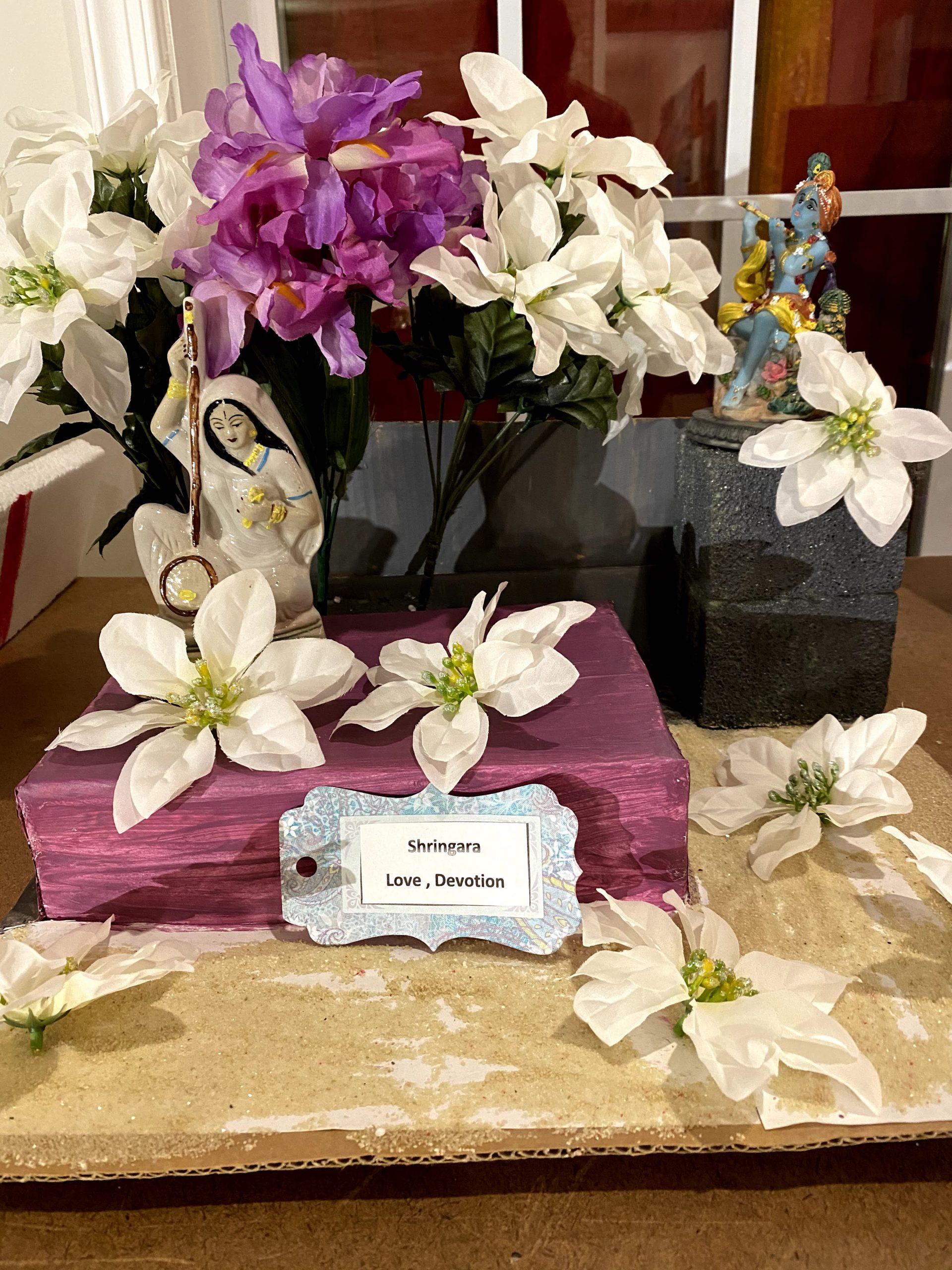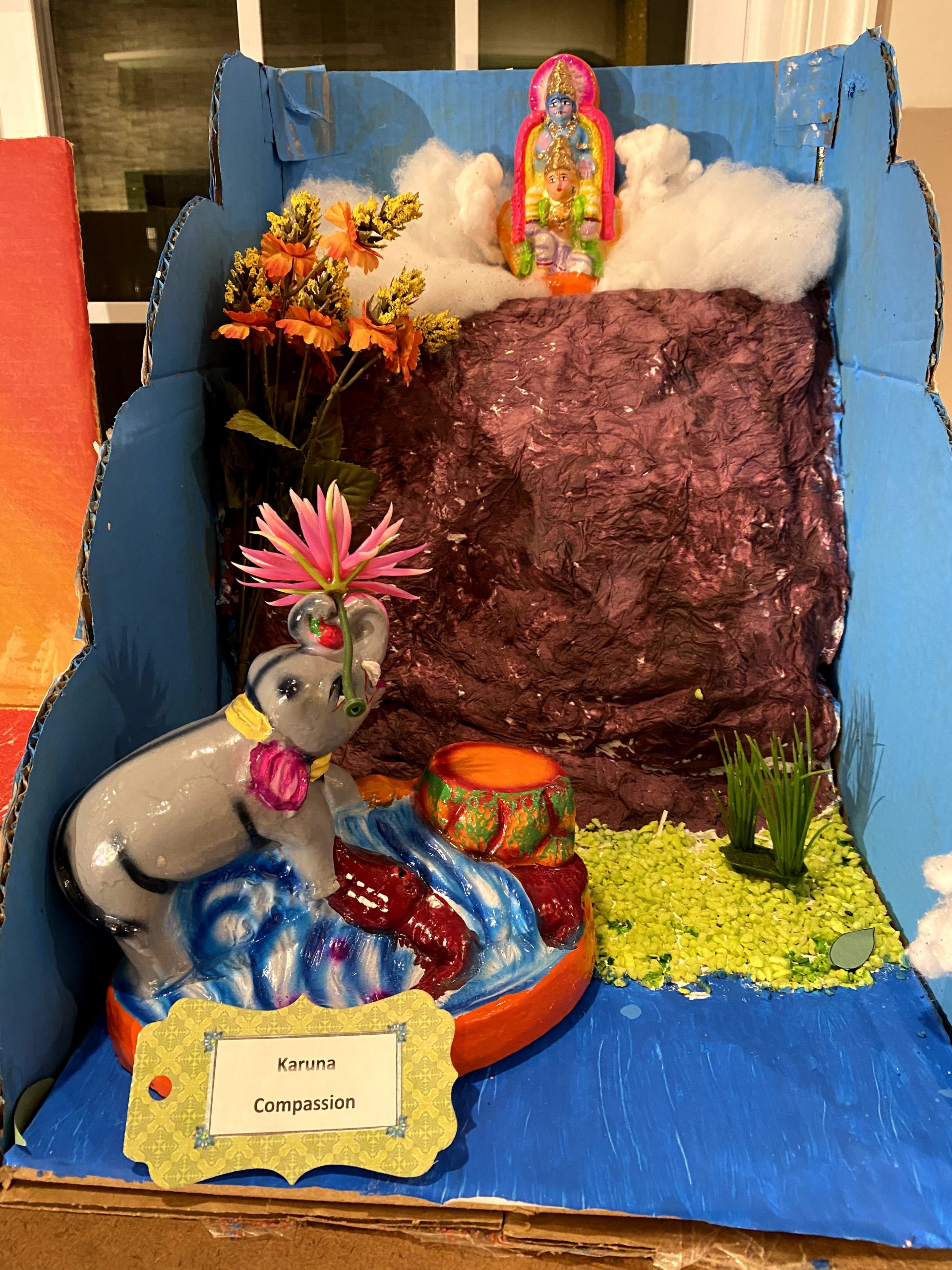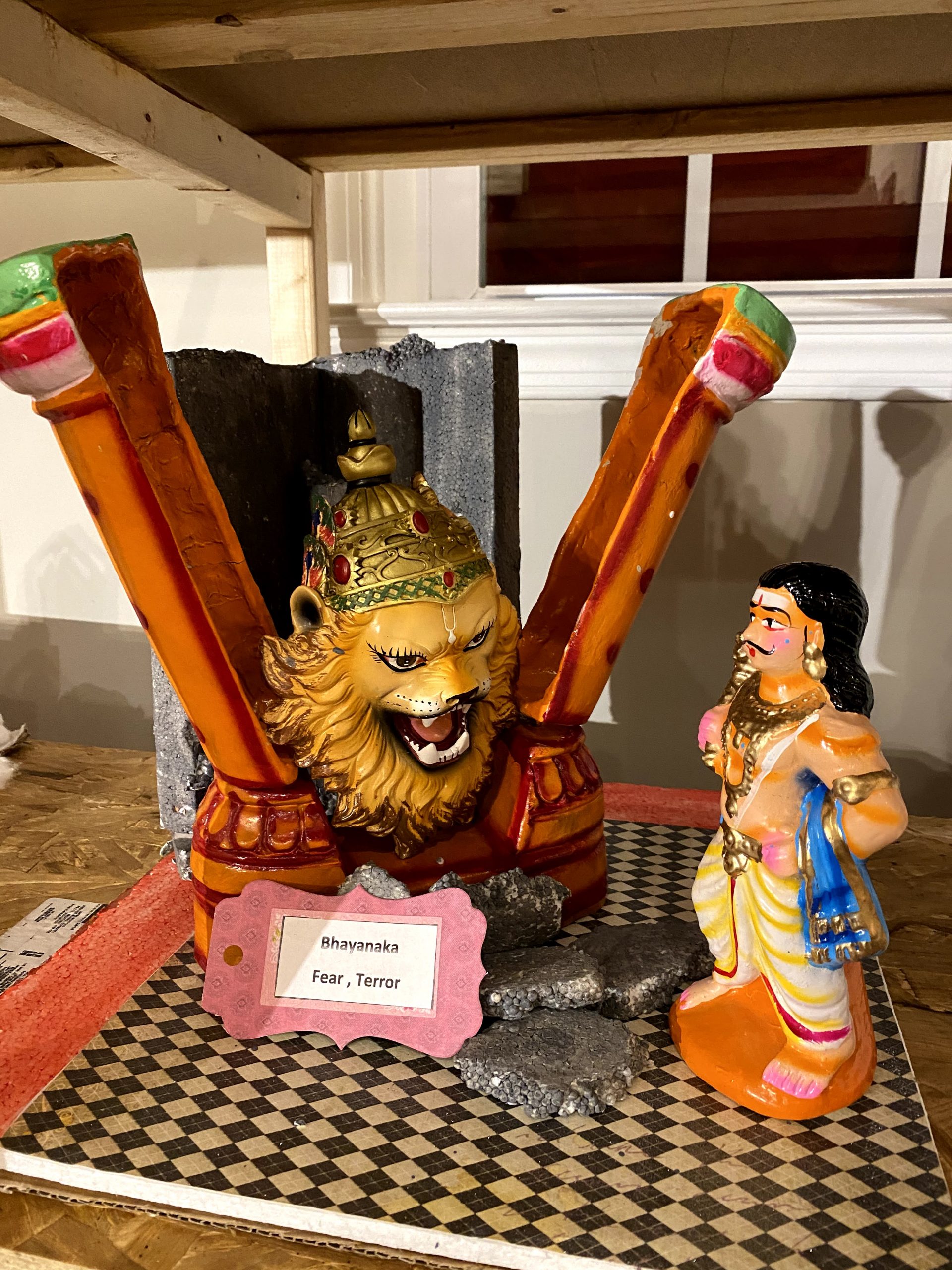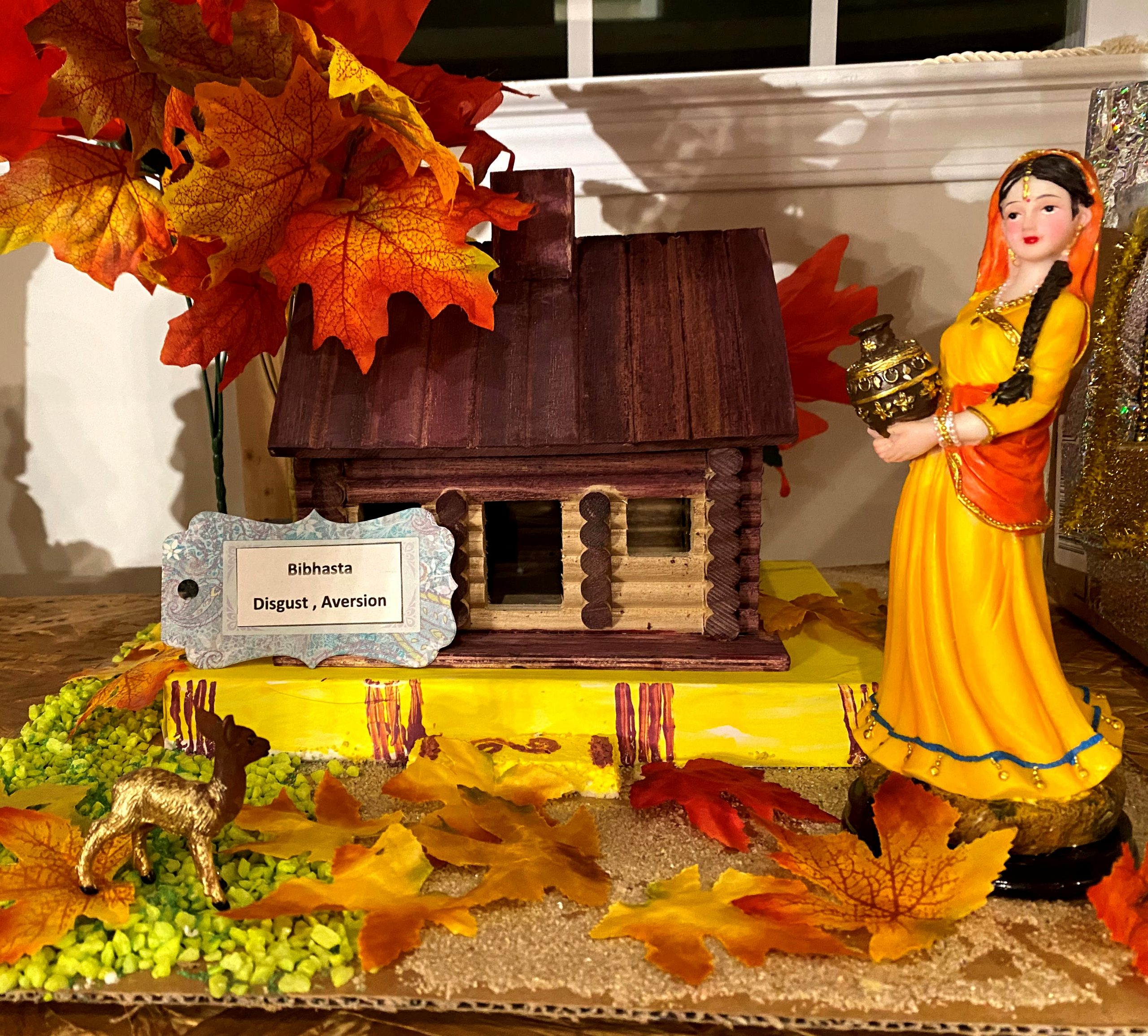Nine Emotions
Navarasas
Navarasa means Nine Emotions in which Nava signifies “Nine” and Rasa signifies “Emotions”. A rasa means “juice, essence or taste”. It connotes a concept in Indian arts about the aesthetic flavour of any visual, literary or musical work that evokes an emotion or feeling in the reader or audience but cannot be described.
We have depicted stories and characters from Hindu Mythology to explain the concept of Navarasa
Shringara - Love / Beauty
Story of Mira Bai & Krishna
Mira Bai is widely known as an incarnation of Radha, the consort of Lord Krishna. She was born in 1499 in a small village called Kurkhi in Marwar, in the state of Rajasthan, India. Mira’s father Ratan Singh belonged to the Ranthors of Merta, who were great devotees of Vishnu. Mira Bai was brought up amidst strong Vaishnava culture that paved her path to the devotion of Lord Krishna. When she was four years of age, she manifested a deep religious keel, and learnt to worship Sri Krishna.
Once seeing a ceremonially dressed bridegroom in a marriage procession, Mira, who was only a child, innocently asked her mother, “Mother, who is my bridegroom?” Mira’s mother pointed towards the image of Sri Krishna and quipped, “My dear Mira, Lord Krishna is your bridegroom”. Since then child Mira began to love the idol of Krishna very much, spending time in bathing, dressing and worshipping the image. She also slept with the idol, talked to it, sang and danced about the image in ecstasy.
She taught the world the way to love God. Her lyrics infuse faith, courage, devotion and love of God. Her Bhajans still act as a soothing balm to the wounded hearts and tired nerves.

Hasya - Laughter
Story of Ganesha & Kuber

Karuna - Compassion
Story of Gajendra the Elephant
There was once an elephant named Gajendra who lived in a garden called Ṛtumat which was created by Varuna. This garden was located on Mount Trikuta, the “Three-Peaked Mountain.” Gajendra ruled over all the other elephants in the herd. One day as usual he went to the lake near by to pick lotus flowers to offer prayer to Lord Vishnu. Suddenly, a crocodile living in the lake attacked Gajendra and caught him by the leg. Gajendra tried for a long time to escape from the crocodile’s clutches. All his family members, relatives and friends gathered around to help him, but in vain. The crocodile simply would not let go. When they realised that ‘death’ had come close to Gajendra, they left him alone. He trumpeted in pain and helplessness until he was hoarse. As the struggle was seemingly endless and when he had spent his last drop of energy, Gajendra called to the god Vishnu to save him, holding a lotus up in the air as an offering.
Hearing his devotee’s call and prayer, Vishnu rushed to the scene. As Gajendra sighted the god coming, he lifted a lotus with his trunk. Seeing this, Vishnu was pleased ,showed compassion and with his Sudharshana Chakra, he decapitated the crocodile. Gajendra prostrated himself before the god. Vishnu informed Gajendra that he, in one of his previous births, had been the celebrated King Indradyumna, a devotee of Vishnu, but due to his disrespect to the great Sage Agastya, he had been cursed to be reborn as an elephant.
Because Indradyumna had been devoted to Vishnu, the god had him born as Gajendra and made him realize that there is something called Kaivalya which is beyond Svarga and Urdhva Loka, the realm of the gods. Indradyumna could attain Moksha finally when he (as Gajendra) left all his pride and doubt and totally surrendered himself to Vishnu.
The prayer made by Gajendra on this occasion became a famous hymn in praise of Vishnu called the Gajendra Stuti
śuklāṃbaradharaṃ viṣṇuṃ śaśi varṇaṃ caturbhujaṃ |
prasanna vadanaṃ dhyāyēta sarva vighnōpaśāntayē ||

Raudra - Anger
Story of Kali
When Goddess Durga, who had ten arms each carrying a weapon and who rode a lion or tiger in battle, fought with Mahishasura (or Mahisa), the buffalo demon. Durga became so enraged that her anger burst from her forehead in the form of Kali. Once born, the black goddess went wild and ate all the demons she came across, stringing their heads on a chain which she wore around her neck. It seemed impossible to calm Kali’s bloody attacks, which now extended to any wrongdoers, and both people and gods were at a loss what to do. Fortunately, the mighty Shiva stopped Kali’s destructive rampage by lying down in her path, and when the goddess realised just who she was standing on, she finally calmed down.

Veera - Heroism / Courage
Krishna and His friends were grazing their cows when one of the cows dropped dead when it drank water from the river Yamuna.
Krishna realized that the culprit behind the poisoning of the Yamuna was Kalinga, the dreaded snake.
The friendly waters of the Yamuna soon became green and nobody could go near the Yamuna any longer. Krishna entered the water to seek out and rout out Kalinga.
The people were shocked and anxious at Krishna’s dare. The whole village assembled on the banks of the river and everyone started pleading with Krishna to return to the shore.
Krishna however found Kalinga and a fierce struggle ensued between them. Krishna then emerged from the waters, dancing on the hood of the fierce Kalinga, holding Kalinga’s tail in His hand.
Seeing her husband in this plight, Kalinga’s wife emerged from the waters and pleaded with Krishna, not to harm Kalinga but to let them off, so that they could go away somewhere far off and not disturb the people.
Krishna let Kalinga and his family off and peace . The waters of the Yamuna sparkled once again. Krishna and His friends returned to their favourite pastime of grazing and playing by the Yamuna.
This incident of Krishna subduing Kalinga displayed the courage / veera of Krishna who was not afraid of a large snake though he was still a small boy.

Bhayanaka - Terror / Fear
Demon King Hiranyakashipu invited the wrath of Lord Vishnu by killing all those who refused to hail him as Bhagwan. The demon king wanted to become the undisputed God of the Universe, and he mercilessly eliminated those, who refused to worship him.
His son Prahlad was born to Kayadhu (Hiranyakashipu’s wife), when the demon was in the Himalayas doing intense penance to please Lord Brahma for obtaining a boon that granted the following to him “Hiranyakashipu could neither be killed by a man nor by an animal; neither at day nor at night; neither at home nor outside; neither on the ground nor in the sky; neither by a weapon nor by supernatural powers”
Interestingly, Prahlad was destined to take birth at the humble abode of Devarshi Narada Muni. Prahlad exhibited divine qualities and was devoted to Lord Vishnu.
Soon after Hiranyakashpu learnt about his son’s devotion to Vishnu, he attempted to dissuade him. But when he failed to do so, he laid several traps to kill him.
One day, when Hiranyakashipu’s tyranny had crossed all limits, Lord Vishnu appeared before him as Narasimha the most ferocious form. The Lord emerged from a pillar in Hiranyakashipu’s court after the latter challenged Prahlad to prove that Vishnu is the most powerful.
Appearing as a half-man-half-lion he terrorized Hiranyakashipu and killed him at dusk at the threshold of his house by making him lie on his lap and executing him with his claws

Bibhatsya - Disgust
Story of Sita Abduction by Ravana
One day, Surpanakha, the rakshasa sister of Ravana, disguised herself as a beautiful maiden and proposed marriage to Rama. Rama refused her proposal and directed her to Lakshmana in jest. Lakshmana joked that she should marry his master Rama. An angry Surpanakha returned to Rama and attacked Sita. But Lakshmana took out his sword and cut off Shurpanakha’s ears and nose. The humiliated Surpanakha reached Lanka and proposed that Ravana steal Sita, Rama’s beautiful wife.
Ravana started brooding and thinking of his next course of action. He then flew in his aerial chariot across the sea to meet his ally, Maricha. Maricha lived in a secluded hermitage on the ocean coast. Maricha and Ravana then flew to Panchavati in Ravana’s chariot and stopped close to the ashram of Rama. Maricha then assumed the form of a beautiful golden deer, which had silver spots and glowed with many gems on its body. Maricha began grazing in the vicinity of Rama’s ashram so that Sita would catch a glimpse of him. Maricha found Sita collecting flowers and ran in front of her. The golden luster of the deer which was gamboling around the hermitage lured Sita, who was awestruck and called Rama and Lakshmana to see the spectacular animal.
On seeing the wondrous deer, Lakshmana sensed foul play and suggested that the deer was an illusory form of a demon. Sita persuaded Rama to get her the deer. Rama decided to go after the deer and slay it and asked Lakshmana to take care of Sita in the meantime. Maricha ran, followed by Rama. Maricha led Rama far away from the hermitage. After a long chase, Rama shot it down with his golden arrow. When the dying Maricha was returning to his real form he cried out, “Oh Sita! Oh Lakshmana!”, mimicking Rama’s voice. Sita fell prey to the ruse and ordered Lakshmana to go. Lakshmana reluctantly left to look for Rama. With Lakshmana gone, Ravana appeared as a mendicant (Sadhu) and kidnapped Sita as she stepped forward to give him alms. The Ramayana then narrates the tale of how Rama defeats Ravana in Lanka and regains Sita.
Abducting another man’s wife was an disgusting act committed by Ravana.

Adbutha - Surprise / Wonder
In Ramayana , during the war with Ravana’s army When Lakshmana fell unconscious, near death, hit by an arrow from Ravana’s son Meghnad, Hanuman approached the Lankan Royal Physician Sushena for advice.
Sushena asked Hanuman to rush to Dronagiri Hills and fetch four plants: Mruthasanjeevani (restorer of life), Vishalyakarani (remover of arrows), Sandhanakarani (restorer of the skin) and Savarnyakarani (restorer of skin colour) (Srimad Valmiki Ramayana, 74th chapter, Yuddakanda, Slokas 29-34).
Hanuman, not able to pick the four from the multitude, brought back the entire hill surprising every one in the warfield. And Lakshmana was revived from near death back to life, and to victory.

Shantha - Peace / Tranquility
During the late 6th and early 5th centuries BCE, Siddhartha Gautama , who later became known as the Buddha, was born in modern-day Nepal near the Indian border. While there are several mythical stories surrounding his conception and birth, the basic facts of his life are generally agreed upon. Born into a wealthy royal family, the Buddha was born and raised in worldly luxury. Despite his father’s attempts to shield him from the ugliness of life, one day he ventured out beyond the castle walls and encountered three aspects of life: the old, the sick and the dead. Each of these experiences troubled him and made him question the meaning and transience of life and its pleasures.
After this, he encountered an ascetic who, by choice, lived a life renouncing the pleasures of the world. Even while he was completely deprived of life’s comforts, his eyes shined with contentment. These shocking experiences moved Buddha to renounce his comfortable lifestyle in search of greater meaning in life. It was during his time practicing extreme forms of self-denial that Buddha discovered the “Middle Path” of moderation — an idea that closely resembles Aristotle’s “Golden Mean.”
During his life, he had experienced intensive pleasure and extreme deprivation but he found that neither extreme brought one to true understanding. He then practiced meditation through deep concentration (Dhyana) under a bodhi tree and found Enlightenment. He began teaching the Four Noble Truths to others in order to help them achieve transcendent happiness and peace of mind through the knowledge and practice that is known today as Buddhism.

